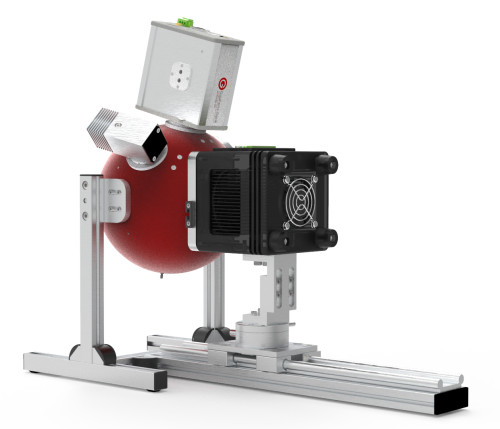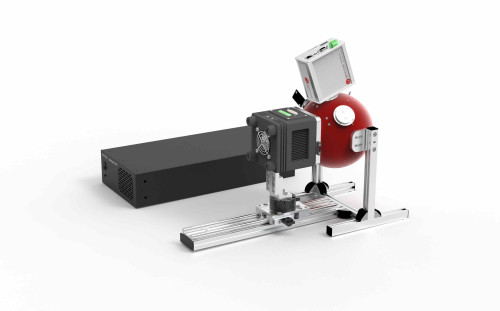Este producto ya no se fabrica. Es posible que queden existencias. Consulte las alternativas que figuran a continuación en "Productos similares" o póngase en contacto con nosotros directamente.
Productos alternativos para este producto descatalogado:

Estación de prueba LED de métodos DCP
Estación de prueba DCP-LED basada en espectrorradiómetro para la potencia radiante de los LED UV
- Método DCP de IES LM-92 y trabajo actual de CIE TC2-91 para mediciones de LED UV de alta precisión.
- VektrexTM SMU implementado para configuraciones de corriente precisas para pulsos cortos y barridos.
- Método DCP implementado en software de aplicación o como herramienta Python (SMU y espectrorradiómetro).
- Esfera integradora sin fluorescencia de 150 mm y espectrorradiómetro con mínima luz parásita y revestimiento ODM.
- Estándar de calibración opcional para la recalibración del sistema por parte del usuario.

Características especiales al medir LED UV-C
Al diseñar un espectrofotómetro de esfera integradora para LED UV, se debe tener en cuenta la peculiaridad de la radiación LED cuasi monocromática. Esto significa que la radiación fluorescente generada por los LED puede provocar errores de medición importantes. Estos errores de medición no se pueden compensar con métodos de corrección convencionales. Los efectos de fluorescencia se pueden reducir a valores por debajo del límite de detección metrológica mediante un pretratamiento del revestimiento de la esfera integradora con una intensa radiación UV.
Consulte también nuestro artículo técnico Medición del flujo radiante sin fluorescencia de LED UV.
Requisitos y solución del método DCP
Para realizar mediciones precisas utilizando el método DCP (IES LM-92-22 y trabajo en curso en CIE TC2-91), son importantes dos cosas:
- Un espectrorradiómetro rápido (rango µs) optimizado para mediciones UV
- Una unidad de medición de fuente (SMU) rápida (pulso de µs)
- Si esto no está suficientemente garantizado, la incertidumbre de la medición aumenta porque los efectos de la temperatura o la vibración generan errores mayores.
Junto con VektrexTM hemos creado una estación de prueba UV-LED para realizar mediciones precisas y rápidas según el método DCP. La corriente varía automáticamente dentro del rango deseado y el escaneo completo se puede realizar en cuestión de segundos a minutos. La medición se puede realizar con un script de Python o con el software de aplicación S-BTS2048.
Esfera integradora para medir el flujo de radiación
Para registrar la radiación LED total emitida, la geometría de medición utilizada es una combinación de un espectrorradiómetro con una esfera integradora, normalmente con un diámetro de 150 mm. La abertura de medición tiene un diámetro de 25,4 mm. El robusto marco del puerto permite la fijación de soportes para LED o del estándar de calibración 2Pi disponible opcionalmente. Son posibles versiones personalizadas de la esfera integradora.
Espectrorradiómetro de alta resolución
El BTS2048-UV es parte de la serie BTS2048 Serie, que ha demostrado su eficacia en una amplia variedad de aplicaciones. Esto incluye el uso de binning de LED de alta velocidad en la producción en masa de LED, así como mediciones a nivel NMI. Ambos son ejemplos que requieren la máxima precisión en el uso continuo. El espectrorradiómetro, conectado directamente a la esfera integradora sin cable de fibra óptica, ofrece un rango de medición espectral de 250 nm a 430 nm. La resolución espectral es de 1 nm. Los filtros ópticos conmutables remotamente aumentan el rango dinámico. Los píxeles de la matriz de fotodiodos estabilizados por temperatura se pueden sincronizar a cero. Esto ofrece la posibilidad de medir pulsos individuales en una cadena de pulsos. Por supuesto, los productos BTS2048 también se pueden utilizar en un rango espectral diferente, por ejemplo, el rango VIS.
Señales dispersas de luz y oscuridad
Las señales de luz y oscuridad dispersas tienen una influencia significativa en los resultados de medición de los espectrorradiómetros UV con sensores de matriz de diodos CCD o CMOS.
La luz dispersa genera señales de medición desde píxeles que no están iluminados por luz útil. Esto limita la exposición monocromática de la radiación LED. Los espectrorradiómetros BTS2048-UV ofrecen una innovadora supresión de luz parásita mediante trampas de luz y filtros ópticos integrados.
La influencia de la señal oscura resulta de las diferentes temperaturas de funcionamiento del dispositivo de medición y de los diferentes tiempos de integración para las diferentes irradiancias. Con la apertura oscura del espectrorradiómetro BTS2048-UV, se puede medir la señal oscura y luego utilizarla para corregir los valores medidos.
Calibración de fábrica y pruebas ISO/IEC/EN 17025
El laboratorio de medición Gigahertz-Optik ofrece calibraciones de fábrica para el DCP-UV-LM92 al más alto nivel en términos de trazabilidad y ejecución de calibración. Esto está garantizado por el hecho de que las calibraciones de fábrica están sujetas a la misma gestión de calidad que se aplica en el laboratorio de pruebas acreditado por DAkkS de Gigahertz-Optik. Por un coste adicional, se pueden emitir certificados de prueba ISO/IEC/EN 17025 acreditados por DAkkS para los instrumentos de medición.

Sistema completo de estación de prueba DCP con espectrorradiómetro y SMU

Vektrex TM Spike Save y BTS2048, una potente combinación
Método DCP (IES LM-92-22) Ejemplo de medición de un LED UV
Productos similares

